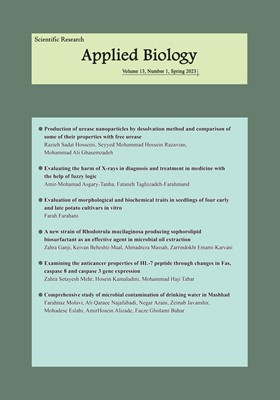Evaluating the harm of X-rays in diagnosis and treatment in medicine with the help of fuzzy logic
Subject Areas :
biology
Amirmohamad Askari-Tanha
1
,
Fataneh Taghizadeh-Farahmand
2
*
1 - M.Sc. Student, Department of Medicalradiation, Faculty of Basic Science, Qom Branch, Islamic Azad University, Qom, Iran.
2 - Associate Professor, Department of Physics, Faculty of Basic Science, Qom Branch, Islamic Azad University, Qom, Iran
Received: 2022-06-28
Accepted : 2023-03-15
Published : 2023-04-21
Keywords:
X-ray,
fuzzy logic,
Medical imaging,
Abstract :
Objective: Fast and correct diagnosis of the disease is very important in many cases. In X-ray medical imaging, the doctor treats the patient without accessing the inside of the body's organs. Therefore, the standard conditions must be met so that the benefits of using X-rays are greater than its disadvantages. Since the presence of medical personnel in imaging centers is now a necessity, they are therefore vulnerable due to constant exposure to the dangers of X-rays. Assessing the level of risk requires the definition of effective parameters that are associated with uncertainty. In this regard, the aim of the current research is to evaluate the harm of X-rays in diagnosis and treatment in medicine with the help of fuzzy logic.Materials and methods: In this research, by using the fuzzy method, and with the help of graphic tools of MATLAB software, and determining four input parameters and one suitable output parameter, and by determining the rules by an expert and the Mamdani fuzzy inference system, the harms of X-rays for the referring person and The treatment panel was checked for imaging.Findings: Examining the data of six selected medical imaging centers in different cities of Iran showed that all these centers are in the medium range of vulnerability to the dangers of X-ray radiation.Conclusion: It seems that the Ministry of Health and Medicine should take more, continuous and serious care regarding safety and protection in medical centers. Safety points must be fully observed, otherwise, in the long run, the treatment staff will face problems with X-ray radiation.
References:
Alexi A. Early History of X Rays. Carbutts. 1995: 10-12.
Amirzadeh F & Tabatabaie SHR. Survey of radiation protection awareness among radiation workers in shiraz hospitals. Iranian Hournal of nuclear Medicine. 2005; 13(2): 38-43.
Awotunde JB, Matiluko OE & Fatai, OW. Medical Diagnosis System Using Fuzzy Logic. African Journal of Computing & ICT. 2014; 7(2).
Bigdelirad MA. Safety tips and protection recommendations. Qazvin University of Medical Sciences and Health Services, 2006. [in persian]
Bushberg JT, Seibert JA, Leidholdt EM & Boone JM. The Essential physics of Medical Imaging. Wolters Kluwer Health, 2011.
Cullity BD. Elements of X-Ray Diffraction. Addison-Wesley Publishing Company, 1978.
Donya M, Radford M, ElGuindy A, Firmin D & Yacoub MH. Radiation in medicine: Origins, risks and aspirations. Global Cardiology Science and Practice. 2015; 57(4).
Dowd SB & Tilson ER. Practical radiation protection and applied radiobiology. Philadelphia, 1999.
Farahani H, Hamta A & Zoalanvari A. Using X-ray diffraction patterns to study healthy and cancerous DNA extracted from induced breast cancer cells. In: 9th International Breast Cancer Congress, 201 [in persian]
Farzaneh A, Ian VM, Sunita C & Gailter H. Bioeffects and safety of low-intensity, low frequency Ultrasonic’s exposure. Prog biophys Mol Biol. 2012; 108: 119-38.
Fatahi-Asl J, Tahmasebi M & Karami V. The protection knowledge and performance of Radiographers in some hospitals of Ahvaz County. Jentashapir J Health Res. 2013; 4: 405-415.
Galdames FJ, Perez CA, Est´evez PA & Held CM. Segmentation of Renal SPECT Images Based on Deformable Models. In: SURGETICA’2005, Computer-Aided Medical Interventions: tools and applications, Chamb´ery, France, 2005: 89–96.
Kamil MY & Salih AM. Breast Tumor Detection Via Fuzzy Morphological Operations. Journal of Advanced Pervasive and biquitous Computing. 2019; 11(1).
Kovalerchuk, B, Triantaphyllou, E, Ruiz JF & Clayton J. Fuzzy logic in computer-aided breast cancer diagnosis: analysis of lobulation. Artificial Intelligence in Medicine. 1997; 11: 75–85.
Masoumbeigi M, Mohseni M, Akbari H & Aliasgharzadeh A. Knowledge of Medical Interns and Radiology Residents, Students, and Staff about the Radiation Dose Received by Patients in Different Imaging Methods. Mazandaran Univ Med Sci. 2016; 26(144): 230-239. [in persian]
Rezaei Vahdati AS & Tahernia AH. Fuzzy expert system for brain tumor diagn In: The 9th Conference of New Researches in Science and Technology, 2017. [in persian]
Samimi, B. Guide to occupational health conditions and control of ionizing radiation in metal industries. Tehran: Ministry of Health, Treatment and Medical Education, Vice-Chancellor of Health, 2016: 188. [in persian]
Valipoor F, Ahmadi O, Poortaghi Gh, Mahmoudi N & Mohamadian M. Survey on scattered and received dose of X-ray radiation in a military hospital. Iran Occupational Health. 2017; 14(1): 134-142. [in persian]
Yang SK & Cheng YI. Huang Biological effect of paramecium in diffused ultrasonic Ultrasonic. 2002; 39: 525-31.
_||_

